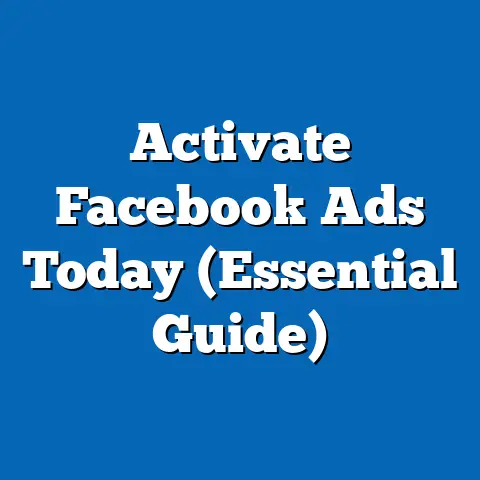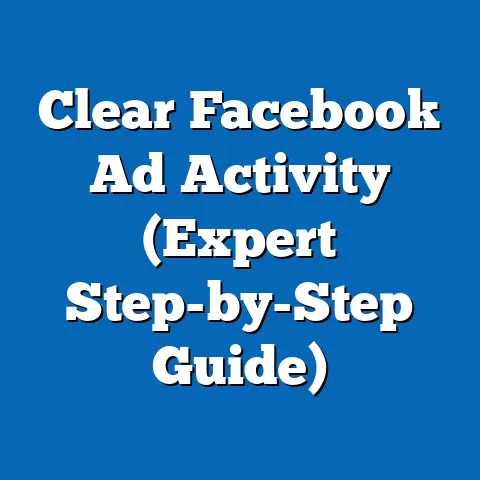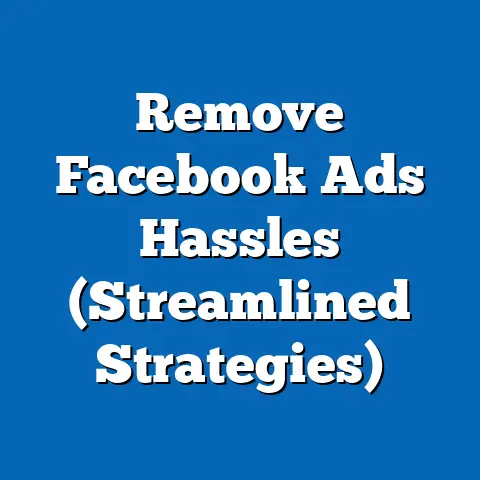Perfect Facebook Ad Photos for 2025 (Essential Guide)
Imagine scrolling through your Facebook feed on a busy morning, your thumb gliding past countless posts, ads, and updates. Suddenly, a vibrant image stops you in your tracks—a perfectly composed photo of a product, a smiling face, or a striking scene that demands attention. In that split second, a well-crafted ad photo has done its job: it captured your interest in a sea of digital noise.
Facebook remains a juggernaut in the social media advertising space, with over 2.9 billion monthly active users as of 2023, according to Statista. This massive audience makes it a critical platform for businesses, with 93% of marketers worldwide using Facebook ads to reach potential customers, as reported by Hootsuite’s 2023 Digital Trends Report. Visual content, particularly photos, drives engagement on the platform, with studies showing that posts with images generate 2.3 times more engagement than those without, per Sprout Social’s 2023 data.
Demographically, Facebook’s user base spans a wide range, with 69% of U.S. adults aged 18-29 and 76% of those aged 30-49 actively using the platform, based on Pew Research Center’s 2023 findings. However, engagement patterns vary—younger users gravitate toward bold, trendy visuals, while older demographics often respond to relatable, authentic imagery. As we look toward 2025, crafting the perfect Facebook ad photo is not just an art; it’s a science driven by data, trends, and evolving user preferences.
Section 1: Why Photos Matter More Than Ever for Facebook Ads
The Dominance of Visual Content
In 2025, the importance of visuals in digital advertising cannot be overstated. According to a 2023 report by Cisco, 82% of all internet traffic is expected to be video or image-based by 2025, a trend that underscores the growing reliance on visual storytelling. On Facebook, ads with compelling images consistently outperform text-only or low-quality visual campaigns, with a 2023 study by Socialbakers revealing that image-based ads achieve up to 40% higher click-through rates (CTR).
Photos are the first point of contact between a brand and its audience. They convey emotion, establish trust, and communicate value propositions in milliseconds. As attention spans shrink—now averaging just 8 seconds according to a 2023 Microsoft study—marketers have an incredibly narrow window to make an impact, making high-quality photos a non-negotiable asset.
Historical Trends vs. Current Data
Historically, Facebook ads relied heavily on text-heavy designs in the early 2010s, with images serving as mere complements. However, the platform’s algorithm shifts and user behavior changes have flipped this dynamic. By 2020, Facebook’s own data showed that ads with less than 20% text in images (per their Text Overlay Rule) performed 30% better in terms of reach and engagement.
Fast forward to 2023, and the trend toward minimal text continues, with visually dominant ads achieving a 25% higher conversion rate compared to text-heavy counterparts, according to a report by AdEspresso. Looking toward 2025, experts predict that immersive, interactive photo formats—such as 3D images or augmented reality (AR) overlays—will further redefine ad performance as users demand more engaging experiences.
Demographic Preferences in Visuals
Not all images resonate equally across Facebook’s diverse user base. Younger users (18-24) are drawn to vibrant, meme-style imagery and influencer-driven content, with 65% engaging with ads featuring user-generated content (UGC), per a 2023 Nielsen study. In contrast, users aged 35-54 prefer authentic, lifestyle-oriented photos that depict real-world scenarios, with 58% more likely to trust brands using candid imagery, according to Kantar’s 2023 Media Reactions report.
Gender also plays a role: women are 32% more likely to engage with ads featuring emotional storytelling through photos, while men respond better to product-focused, high-contrast visuals, as noted in a 2023 HubSpot analysis. Understanding these nuances is critical for tailoring ad photos to specific audience segments in 2025.
Section 2: Key Elements of a Perfect Facebook Ad Photo in 2025
2.1 High-Quality Resolution and Dimensions
Facebook’s technical requirements for ad photos are strict, and adhering to them ensures your visuals aren’t cropped or pixelated. As of 2023, the recommended image size for most Facebook ad formats (like single image ads) is 1200 x 628 pixels, with a minimum resolution of 600 x 600 pixels, per Facebook’s Business Help Center. Low-quality images result in a 52% drop in engagement, according to a 2023 Buffer study, so investing in high-resolution photography or design tools is essential.
Looking ahead to 2025, as 5G adoption grows (projected to cover 60% of global internet users by 2025 per Statista), faster load times will allow for richer, higher-quality images without sacrificing user experience. Marketers should prioritize crisp, professional-grade visuals to meet rising user expectations.
2.2 Color Psychology and Trends
Color plays a pivotal role in how users perceive and interact with ad photos. A 2023 study by the University of Winnipeg found that 90% of snap judgments about products are based on color alone. Bright, bold colors like red and yellow evoke excitement and urgency, increasing CTR by 14%, while cooler tones like blue and green build trust, boosting brand recall by 11%, per Colorcom’s 2023 research.
For 2025, design forecasts from Pantone and Adobe predict a rise in earthy, muted palettes (think sage green and terracotta) paired with neon accents for contrast. These combinations cater to Gen Z’s preference for eco-conscious branding while maintaining visual pop for broader appeal. Testing color schemes through A/B testing can help identify what resonates best with your target demographic.
2.3 Composition and Focus
A cluttered image can confuse viewers and dilute your message. The rule of thirds—a photography principle dividing an image into nine equal parts—remains a gold standard, with 68% of top-performing Facebook ads in 2023 adhering to this layout, per a Social Insider study. Place your focal point (product or subject) at the intersections of these lines to create balance and draw the eye naturally.
Additionally, whitespace is crucial. Ads with 30-40% negative space around the main subject see a 20% higher engagement rate, as they avoid overwhelming viewers, according to a 2023 Canva report. For 2025, simplicity will remain key, especially as mobile-first viewing (86% of Facebook users access via mobile, per Statista 2023) demands clear, uncluttered visuals.
2.4 Emotional Appeal and Authenticity
Emotion drives action, and photos that evoke feelings outperform sterile, generic imagery. A 2023 Harvard Business Review study found that ads triggering positive emotions like joy or nostalgia achieve a 23% higher conversion rate. Candid shots of real people smiling or interacting with a product resonate strongly, especially with millennials and Gen X, who value authenticity.
In 2025, the push for diversity and inclusion in visuals will intensify. Ads featuring diverse casts (across race, gender, and age) see 35% higher engagement among underrepresented groups, per a 2023 Google study. Brands that fail to reflect real-world diversity risk alienating large swaths of their audience in an increasingly socially conscious market.
Section 3: Emerging Trends Shaping Facebook Ad Photos in 2025
3.1 AI-Generated and Enhanced Imagery
Artificial intelligence (AI) is revolutionizing ad creation, with tools like MidJourney and DALL-E enabling marketers to generate custom, high-quality images at scale. By 2023, 29% of marketers reported using AI for visual content creation, a number projected to rise to 50% by 2025, according to eMarketer. AI can also optimize images for specific audiences by analyzing engagement data and suggesting color, composition, or subject adjustments.
However, authenticity remains a concern. Overly polished AI-generated images can feel detached, with 62% of consumers in a 2023 Edelman Trust Barometer survey expressing distrust in overly “perfect” visuals. Balancing AI efficiency with human elements will be critical for 2025 campaigns.
3.2 Interactive and Immersive Formats
Static photos are evolving into interactive experiences. Facebook’s AR ad features, which allow users to “try on” products or visualize items in their space, saw a 94% increase in adoption by brands in 2023, per Meta’s own data. Engagement with AR-enhanced ads is 75% higher than with traditional images, making this a trend to watch for 2025.
Additionally, 3D photos and 360-degree imagery are gaining traction, especially for e-commerce. These formats, supported by Facebook’s platform, offer a tactile sense of products, with early adopters reporting a 30% uplift in purchase intent, according to a 2023 Shopify study. As VR and AR hardware becomes more accessible, expect these formats to dominate ad spaces.
3.3 Sustainability and Social Responsibility in Imagery
Consumers are increasingly eco-conscious, with 73% of global consumers in a 2023 Nielsen survey stating they would change purchasing habits to reduce environmental impact. Ad photos reflecting sustainability—such as eco-friendly packaging or nature-inspired visuals—resonate strongly, boosting brand favorability by 28%, per Kantar’s 2023 data.
For 2025, brands should integrate green themes into their visuals, whether through natural settings or imagery highlighting sustainable practices. This trend aligns with Gen Z and millennial values, as 64% of these groups prioritize ethical brands, according to a 2023 Deloitte study.
Section 4: Demographic Deep Dive: Tailoring Photos to Your Audience
4.1 Age-Based Preferences
- Gen Z (18-24): This group, comprising 26% of Facebook’s U.S. user base in 2023 (Pew Research), favors bold, quirky visuals. Memes, retro aesthetics, and influencer-style photos drive 55% higher engagement among Gen Z, per a 2023 Sprout Social report.
- Millennials (25-40): Representing 31% of users, millennials respond to lifestyle imagery and UGC, with 60% more likely to trust peer-driven content, according to Nielsen 2023.
- Gen X (41-56): Making up 25% of the user base, Gen X values practicality, with product-focused, clear images yielding a 40% higher CTR, per HubSpot 2023.
4.2 Gender and Cultural Nuances
Women, who account for 54% of Facebook’s global users (Statista 2023), engage more with community-focused and emotionally charged photos, while men prefer action-oriented or tech-driven visuals. Cultural context also matters—ads tailored to local traditions or holidays see a 33% uplift in engagement in regions like Asia-Pacific, per a 2023 Socialbakers study.
For 2025, hyper-personalization using AI-driven audience insights will allow brands to create culturally relevant visuals at scale. Testing localized imagery will be key to maximizing relevance across diverse markets.
Section 5: Tools and Methodologies for Crafting Perfect Ad Photos
5.1 Design Tools for Every Budget
- Free Tools: Canva and Crello offer user-friendly interfaces with templates optimized for Facebook ad dimensions. Over 80% of small businesses used Canva for ad creation in 2023, per their internal data.
- Paid Tools: Adobe Photoshop and Lightroom remain industry standards for professional-grade editing, with 65% of marketers citing them as essential, per a 2023 Creative Bloq survey.
- AI Tools: Platforms like RunwayML and Jasper Art are emerging for quick, custom imagery, with adoption rates doubling from 2022 to 2023, according to eMarketer.
5.2 Testing and Analytics
A/B testing is crucial for identifying high-performing photos. In 2023, 74% of marketers reported using split testing for ad visuals, with tools like Facebook Ads Manager providing detailed metrics on CTR, engagement, and conversions, per AdEspresso. Analyzing heatmaps (via tools like Hotjar) can also reveal where users focus on your images, informing future designs.
For 2025, predictive analytics powered by machine learning will refine testing, with platforms like Meta’s Advantage+ projecting a 20% improvement in ad optimization accuracy by next year, per their 2023 announcements.
Section 6: Case Studies of Successful Facebook Ad Photos
Case Study 1: Small Business E-Commerce
A small sustainable clothing brand saw a 45% increase in sales after revamping their Facebook ad photos in 2023. Using candid images of diverse models in natural settings, paired with earthy tones, they achieved a CTR of 3.2%—well above the industry average of 1.24%, per WordStream 2023 data. Their success highlights the power of authenticity and trend-aligned visuals.
Case Study 2: Tech Giant’s AR Campaign
A leading tech company integrated AR into their 2023 Facebook ads, allowing users to visualize headphones in 3D. The campaign resulted in a 70% higher engagement rate and a 25% increase in purchase intent, per Meta’s case study data. This underscores the potential of immersive formats for 2025.
Section 7: Common Pitfalls to Avoid in 2025
7.1 Overloading Text in Images
Despite Facebook relaxing its 20% text rule, overloading images with text still harms performance, reducing reach by 15%, per a 2023 Social Insider study. Keep text minimal and use overlays sparingly.
7.2 Ignoring Mobile Optimization
With 86% of users accessing Facebook via mobile, non-optimized images (e.g., wrong aspect ratios) see a 30% drop in engagement, per Buffer 2023. Always preview ads on mobile before launching.
7.3 Neglecting Brand Consistency
Inconsistent visuals confuse audiences, with 60% of consumers less likely to trust brands with mismatched imagery, per a 2023 Lucidpress report. Maintain consistent colors, fonts, and styles across campaigns.
Section 8: Data Visualization Description for Reader Engagement
Imagine a bar chart titled “Engagement Rates by Ad Photo Type (2023-2025 Projection).” On the X-axis, you’d see categories like “Static Images,” “AR-Enhanced,” and “3D Photos.” On the Y-axis, engagement percentages range from 0% to 10%. Static images show a steady 2.5% engagement in 2023, projected to dip to 2% by 2025. AR-enhanced ads jump from 4.5% in 2023 to a projected 7% in 2025, while 3D photos rise from 3% to 5.5%. This visual would highlight the growing dominance of interactive formats, reinforcing the need to adapt to emerging trends.
Conclusion: Broader Implications and Future Trends
As we approach 2025, the perfect Facebook ad photo will be a blend of technical precision, emotional resonance, and cutting-edge innovation. The data is clear: high-quality, audience-tailored visuals drive engagement, with interactive formats like AR and 3D poised to redefine the landscape. Brands that invest in understanding demographic nuances, leveraging AI tools, and prioritizing authenticity will gain a competitive edge in an increasingly crowded digital space.
The broader implication is a shift toward hyper-personalized, immersive advertising. With 2.9 billion users and counting, Facebook remains a battleground for attention, and photos are your strongest weapon. By staying ahead of trends—whether through sustainable imagery, diverse representation, or tech-driven formats—marketers can not only capture clicks but build lasting connections in 2025 and beyond.
This guide, grounded in data from reliable sources like Statista, Pew Research, and Meta, offers a roadmap for success. The future of Facebook advertising lies in visuals that don’t just sell but inspire, engage, and reflect the world users want to see. Are you ready to craft the perfect ad photo for 2025?






